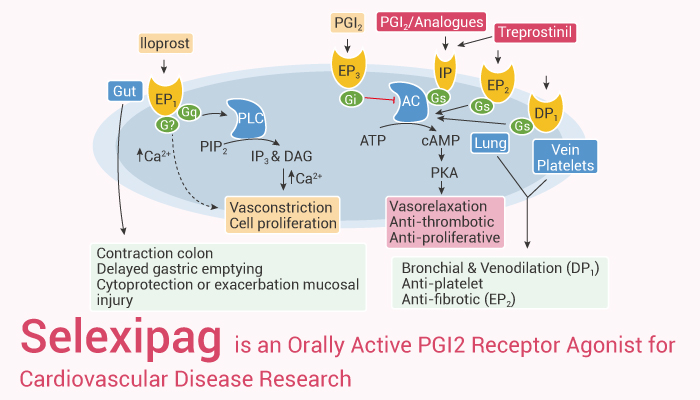The Prostacyclin receptor (also termed the prostaglandin I2 receptor or just IP) is a receptor belonging to the prostaglandin (PG) group of receptors. IP binds to and mediates the biological actions of prostacyclin. IP is encoded in humans by the PTGIR gene. While possessing many functions as defined in animal model studies, the major clinical relevancy of IP is as a powerful vasodilator. Stimulators of IP are used to treat severe and even life-threatening diseases involving pathological vasoconstriction.

Selexipag is an Orally Active and Potent PGI2 Receptor Agonist
Selexipag (NS-304) is an orally available and potent agonist for the Prostacyclin (PGI2) receptor (IP receptor).
In Vitro, Selexipag is an orally available and long-acting IP receptor agonist prodrug. And its active form, MRE-269, is highly selective for the IP receptor. Selexipag inhibits the binding of [3H]Iloprost to the human and rat IP receptors in a concentration-dependent manner. The Ki value is 260 nM for the human IP receptor and 2100 nM for the rat IP receptor. Selexipag increases intracellular cAMP levels in hIP-CHO cells in a concentration-dependent manner with an EC50 of 177nM. Selexipag also inhibits platelet aggregation in humans and monkeys with IC50 values of 5.5 and 3.4 μM, respectively. But it shows no inhibition in dogs.
In Vivo, the Cmax of MRE-269 after oral administration of Selexipag is 1.1 μg/mL in rats and 9.0 μg/mL in dogs. And Selexipag at 1 or 3 mg/kg increases FSBF in anesthetized rats for more than 4 h after intraduodenal administration in a dose-dependent manner. In particular, Selexipag at 3 mg/kg causes a sustained increase in FSBF and exhibits a maximal increase of 93% in FSBF 1 h after administration.
In conclusion, Selexipag is an orally active and potent PGI2 receptor agonist for cardiovascular disease research.
Reference:
[1]. J Pharmacol Exp Ther. 2007 Sep;322(3):1181-8.
[2]. Am J Physiol Lung Cell Mol Physiol. 2018 May 10.